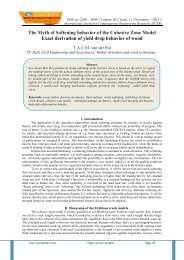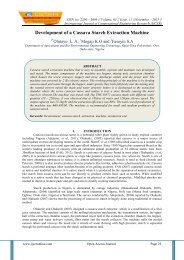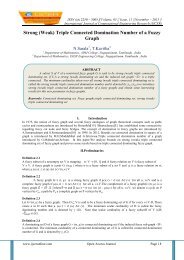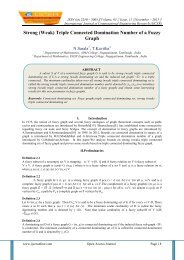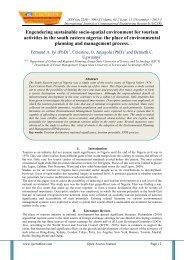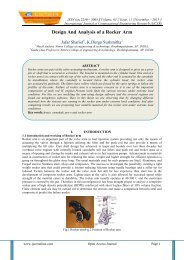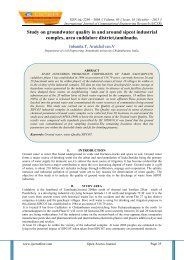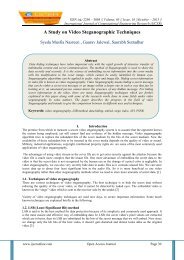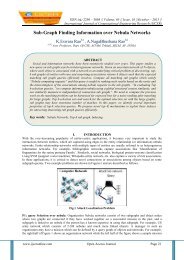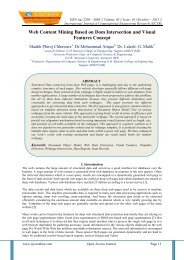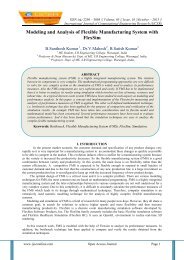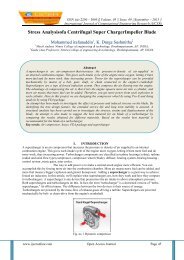Efficient Resource Allocation to Virtual Machine in Cloud Computing Using an Advance Algorithm
The focus of the paper is to generate an advance algorithm of resource allocation and load balancing that can deduced and avoid the dead lock while allocating the processes to virtual machine. In VM while processes are allocate they executes in queue , the first process get resources , other remains in waiting state .As rest of VM remains idle . To utilize the resources, we have analyze the algorithm with the help of First-Come, First-Served (FCFS) Scheduling, Shortest-Job-First (SJR) Scheduling, Priority Scheduling, Round Robin (RR) and CloudSIM Simulator.
The focus of the paper is to generate an advance algorithm of resource allocation and load balancing that can deduced and avoid the dead lock while allocating the processes to virtual machine. In VM while processes are allocate they executes in queue , the first process get resources , other remains in waiting state .As rest of VM remains idle . To utilize the resources, we have analyze the algorithm with the help of First-Come, First-Served (FCFS) Scheduling, Shortest-Job-First (SJR) Scheduling, Priority Scheduling, Round Robin (RR) and CloudSIM Simulator.
Create successful ePaper yourself
Turn your PDF publications into a flip-book with our unique Google optimized e-Paper software.
ISSN (e): 2250 – 3005 || Volume, 05 || Issue, 10 ||Oc<strong>to</strong>ber – 2015 ||<br />
International Journal of Computational Eng<strong>in</strong>eer<strong>in</strong>g Research (IJCER)<br />
<strong>Efficient</strong> <strong>Resource</strong> <strong>Allocation</strong> <strong>to</strong> <strong>Virtual</strong> <strong>Mach<strong>in</strong>e</strong> <strong>in</strong> <strong>Cloud</strong><br />
Comput<strong>in</strong>g Us<strong>in</strong>g <strong>an</strong> Adv<strong>an</strong>ce <strong>Algorithm</strong><br />
Rajeev Kumar 1 , Aditya Sharma 2<br />
1 Deptt. of C.S.E.,Arni University, K<strong>an</strong>gra,India<br />
2 Deptt. of C.S.E, Arni University, K<strong>an</strong>gra, India<br />
ABSTRACT:<br />
The focus of the paper is <strong>to</strong> generate <strong>an</strong> adv<strong>an</strong>ce algorithm of resource allocation <strong>an</strong>d load<br />
bal<strong>an</strong>c<strong>in</strong>g that c<strong>an</strong> deduced <strong>an</strong>d avoid the dead lock while allocat<strong>in</strong>g the processes <strong>to</strong> virtual mach<strong>in</strong>e.<br />
In VM while processes are allocate they executes <strong>in</strong> queue , the first process get resources , other<br />
rema<strong>in</strong>s <strong>in</strong> wait<strong>in</strong>g state .As rest of VM rema<strong>in</strong>s idle . To utilize the resources, we have <strong>an</strong>alyze the<br />
algorithm with the help of First-Come, First-Served (FCFS) Schedul<strong>in</strong>g, Shortest-Job-First (SJR)<br />
Schedul<strong>in</strong>g, Priority Schedul<strong>in</strong>g, Round Rob<strong>in</strong> (RR) <strong>an</strong>d <strong>Cloud</strong>SIM Simula<strong>to</strong>r.<br />
KEYWORDS: VM(<strong>Virtual</strong> mach<strong>in</strong>e)<br />
I. INTRODUCTION<br />
<strong>Cloud</strong> comput<strong>in</strong>g has attracted attention as <strong>an</strong> import<strong>an</strong>t platform for software deployment, with perceived<br />
benefits such as elasticity <strong>to</strong> fluctuat<strong>in</strong>g load, <strong>an</strong>d reduced operational costs compared <strong>to</strong> runn<strong>in</strong>g <strong>in</strong> enterprise<br />
data centers. While some software is written from scratch especially for the cloud, m<strong>an</strong>y org<strong>an</strong>izations also wish<br />
<strong>to</strong> migrate exist<strong>in</strong>g applications <strong>to</strong> a cloud platform. A cloud environment is one of the most shareable<br />
environments where multiple clients are connected <strong>to</strong> the common environment <strong>to</strong> access the services <strong>an</strong>d the<br />
products. A cloud environment c<strong>an</strong> be public or the private cloud. In such environment, all the resources are<br />
available on <strong>an</strong> <strong>in</strong>tegrated environment where multiple users c<strong>an</strong> perform the request at same time. In such case ,<br />
some approach is required <strong>to</strong> perform the effective schedul<strong>in</strong>g <strong>an</strong>d the resource allocation.<br />
II. RESOURCE ALLOCATION<br />
There are different algorithm that def<strong>in</strong>es the load bal<strong>an</strong>c<strong>in</strong>g <strong>to</strong> provide resources on the criteria as follow<strong>in</strong>g<br />
2.1 Token Rout<strong>in</strong>g: The ma<strong>in</strong> objective of the algorithm is <strong>to</strong> m<strong>in</strong>imize the system cost by mov<strong>in</strong>g the <strong>to</strong>kens<br />
around the system. But <strong>in</strong> a scalable cloud system agents c<strong>an</strong>not have the enough <strong>in</strong>formation of distribut<strong>in</strong>g the<br />
work load due <strong>to</strong> communication bottleneck. So the workload distribution among the agents is not fixed. The<br />
drawback of the <strong>to</strong>ken rout<strong>in</strong>g algorithm c<strong>an</strong> be removed with the help of heuristic approach of <strong>to</strong>ken based load<br />
bal<strong>an</strong>c<strong>in</strong>g. This algorithm provides the fast <strong>an</strong>d efficient rout<strong>in</strong>g decision. In this algorithm agent does not need<br />
<strong>to</strong> have <strong>an</strong> idea of the complete knowledge of their global state <strong>an</strong>d neighbor’s work<strong>in</strong>g load. To make their<br />
decision where <strong>to</strong> pass the <strong>to</strong>ken they actually build their own knowledge base. This knowledge base is actually<br />
derived from the previously received <strong>to</strong>kens. So <strong>in</strong> this approach no communication overhead is generated.<br />
2.2 Round Rob<strong>in</strong>: In this algorithm, the processes are divided between all processors. Each process is assigned<br />
<strong>to</strong> the processor <strong>in</strong> a round rob<strong>in</strong> order. The process allocation order is ma<strong>in</strong>ta<strong>in</strong>ed locally <strong>in</strong>dependent of the<br />
allocations from remote processors. Though the work load distributions between processors are equal but the job<br />
process<strong>in</strong>g times for different processes are not same. So at <strong>an</strong>y po<strong>in</strong>t of time some nodes may be heavily loaded<br />
<strong>an</strong>d others rema<strong>in</strong> idle. This algorithm is mostly used <strong>in</strong> web servers where Http requests are of similar nature<br />
<strong>an</strong>d distributed equally.<br />
2.3 R<strong>an</strong>domized: R<strong>an</strong>domized algorithm is of type static <strong>in</strong> nature. In this algorithm process c<strong>an</strong> be h<strong>an</strong>dled by<br />
a particular node n with a probability p. The process allocation order is ma<strong>in</strong>ta<strong>in</strong>ed for each processor<br />
<strong>in</strong>dependent of allocation from remote processor.<br />
This algorithm works well <strong>in</strong> case of processes are of equal loaded. [10]. However, problem arises when loads<br />
are of different computational complexities. R<strong>an</strong>domized algorithm does not ma<strong>in</strong>ta<strong>in</strong> determ<strong>in</strong>istic approach. It<br />
works well when Round Rob<strong>in</strong> algorithms generate solver head for process queue.<br />
www.ijceronl<strong>in</strong>e.com Open Access Journal Page 7
<strong>Efficient</strong> <strong>Resource</strong> <strong>Allocation</strong> <strong>to</strong> <strong>Virtual</strong> <strong>Mach<strong>in</strong>e</strong>…<br />
2.4 Central queu<strong>in</strong>g: This algorithm works on the pr<strong>in</strong>cipal of dynamic distribution. Each new activity arriv<strong>in</strong>g<br />
at the queue m<strong>an</strong>ager is <strong>in</strong>serted <strong>in</strong><strong>to</strong> the queue. When request for <strong>an</strong> activity is received by the queue m<strong>an</strong>ager it<br />
removes the first activity from the queue <strong>an</strong>d sends it <strong>to</strong> the requester. If no ready activity is present <strong>in</strong> the queue<br />
the request is buffered, until a new activity is available. But <strong>in</strong> case new activity comes <strong>to</strong> the queue while there<br />
are un<strong>an</strong>swered requests <strong>in</strong> the queue the first such request is removed from the queue <strong>an</strong>d new activity is<br />
assigned <strong>to</strong> it. When a processor load falls under the threshold then the local load m<strong>an</strong>ager sends a request for<br />
the new activity <strong>to</strong> the central load m<strong>an</strong>ager.<br />
2.6 Connection mech<strong>an</strong>ism: Load bal<strong>an</strong>c<strong>in</strong>g algorithm c<strong>an</strong> also be based on least connection mech<strong>an</strong>ism which<br />
is a part of dynamic schedul<strong>in</strong>g algorithm. It needs <strong>to</strong> count the number of connections for each server<br />
dynamically <strong>to</strong> estimate the load. The load bal<strong>an</strong>cer records the connection number of each server. The number<br />
of connection <strong>in</strong>creases when a new connection is dispatched <strong>to</strong> it, <strong>an</strong>d decreases the number when connection<br />
f<strong>in</strong>ishes or timeout happens.<br />
III. ALGORITHM<br />
The algorithm provide parallel processes <strong>to</strong> each virtual mach<strong>in</strong>e rather th<strong>an</strong> serial processes one by one.<br />
Figure 1. VM Function<br />
*a. *Input the M number of <strong>Cloud</strong>s with L1, L2, L3………….., Ln (n tends <strong>to</strong> no. of last virtual<br />
mach<strong>in</strong>e))number of <strong>Virtual</strong> <strong>Mach<strong>in</strong>e</strong>s associated with each cloud.<br />
*b. *Def<strong>in</strong>e the available memory <strong>an</strong>d load for each virtual mach<strong>in</strong>e.<br />
*c. *Assign the priority <strong>to</strong> each cloud.<br />
*d. *Input n number of user process request with some parameters specifications like arrival time, process time,<br />
required memory etc.<br />
*e. *Arr<strong>an</strong>ge the process requests <strong>in</strong> order of memory requirement<br />
*f. *For i=1 <strong>to</strong> n<br />
*g. *{<br />
*h. *Identify the priority <strong>Cloud</strong> <strong>an</strong>d Associated VM hav<strong>in</strong>g Available<br />
Memory(L1,L2,L3…………Ln)>Required Memory(i)<br />
*i. *Perform the <strong>in</strong>itial allocation of process <strong>to</strong> that particular VM <strong>an</strong>d<br />
the <strong>Cloud</strong><br />
*j. *}<br />
*k. *For i=1 <strong>to</strong> n<br />
*l. *{<br />
*m. *Identify the Free Time slot on priority cloud <strong>to</strong> perform the allocation. As the free slot identify, record the<br />
start time, process time, turnaround time <strong>an</strong>d the deadl<strong>in</strong>e of the process.<br />
*n. *}<br />
*o. *fori=1 <strong>to</strong> n<br />
*p. *(<br />
*q.* start queue Q1.<br />
*r. *{<br />
*s. Process i1allocate <strong>to</strong> VM L1.<br />
*t. *Pr<strong>in</strong>t "Migration Done”<br />
*u. Process i2, i3………<strong>in</strong> allocate <strong>to</strong> VM L2, L3………………,Ln respectively.<br />
*w.* Q1, i1, p1 ends till i(n+1) allots <strong>to</strong> L1 aga<strong>in</strong>.<br />
*X. * start new Queue Q2 [i (n+1)],<br />
Q3 {I (2n+1)},……………. Respectively.<br />
*y. *}<br />
*z. *}<br />
www.ijceronl<strong>in</strong>e.com Open Access Journal Page 8
<strong>Efficient</strong> <strong>Resource</strong> <strong>Allocation</strong> <strong>to</strong> <strong>Virtual</strong> <strong>Mach<strong>in</strong>e</strong>…<br />
IV.<br />
EXPERIMENTAL REVIEW<br />
Larger wait<strong>in</strong>g time <strong>an</strong>d Response time<br />
In round rob<strong>in</strong> architecture the time the process spends <strong>in</strong> the ready queue wait<strong>in</strong>g for the processor <strong>to</strong> get<br />
executed is known as wait<strong>in</strong>g time <strong>an</strong>d the time [13] the process completes its<br />
Intelligent time slice generation<br />
Figure: Process schedul<strong>in</strong>g <strong>in</strong> shortest round rob<strong>in</strong><br />
A new way of <strong>in</strong>telligent time slice calculation has been proposed which allocates the frame exclusively for each<br />
task based on priority, shortest CPU burst time <strong>an</strong>d context switch avoid<strong>an</strong>ce time.<br />
Let the orig<strong>in</strong>al time slice (OTS) is the time slice <strong>to</strong> be given <strong>to</strong> <strong>an</strong>y process if it deserves no special<br />
consideration<br />
The <strong>in</strong>telligent time slice of process P1 is same as the orig<strong>in</strong>al time slice of four milliseconds <strong>an</strong>d time slice of<br />
four milliseconds is assigned <strong>to</strong> process P1. After the execution of four milliseconds time slice the CPU is<br />
allocated <strong>to</strong> process P2. S<strong>in</strong>ce the CPU burst of process P2 is lesser th<strong>an</strong> the assumed CPU burst (ATS), one<br />
milliseconds of SC has been <strong>in</strong>cluded. The process P3 has the highest priority, so priority component is added<br />
<strong>an</strong>d the <strong>to</strong>tal of five milliseconds is allocated <strong>to</strong> process P3. The Bal<strong>an</strong>ced CPU burst for process P4 is leaser<br />
th<strong>an</strong> OTS, context switch component is added <strong>an</strong>d a <strong>to</strong>tal of eight millisecond time slice is given <strong>to</strong> process P4.<br />
Process P5 is given a <strong>to</strong>tal of five milliseconds with one millisecond of priority component is added <strong>to</strong> orig<strong>in</strong>al<br />
time slice. After execut<strong>in</strong>g a cycle the processor will aga<strong>in</strong> be allocated <strong>to</strong> process P1 for the next cycle <strong>an</strong>d<br />
cont<strong>in</strong>uously schedules <strong>in</strong> the same m<strong>an</strong>ner.<br />
Steps for schedul<strong>in</strong>g are as follows<br />
Step 1:<br />
Master system (VMM) receives <strong>in</strong>formation regard<strong>in</strong>g virtual mach<strong>in</strong>e from slave (VM-1….n). If the master<br />
node capability doesn’t catch the data, it will determ<strong>in</strong>e the virtual mach<strong>in</strong>e <strong>to</strong> be dead. This study proposed by<br />
parameter W.<br />
If W=0 is set up, it will def<strong>in</strong>e the virtual mach<strong>in</strong>e <strong>to</strong> be work<strong>in</strong>g <strong>an</strong>d still alive now.<br />
If W=1 then node is dead.<br />
If W=2 then node is <strong>in</strong> previous state.<br />
Step 2: If Master node receives the data from slave, then it gets the <strong>in</strong>formation’s regard<strong>in</strong>g data (memory used,<br />
CPU time etc...)<br />
Step 3: Then Master node builds the weighted table conta<strong>in</strong><strong>in</strong>g the details which is collected from step 2.<br />
www.ijceronl<strong>in</strong>e.com Open Access Journal Page 9
<strong>Efficient</strong> <strong>Resource</strong> <strong>Allocation</strong> <strong>to</strong> <strong>Virtual</strong> <strong>Mach<strong>in</strong>e</strong>…<br />
Step 4: Then the master node sorts (Round-rob<strong>in</strong> method) all the virtual mach<strong>in</strong>es accord<strong>in</strong>g <strong>to</strong> their<br />
perform<strong>an</strong>ce. Which is 1≦i≦N.Where N is the number of the virtual mach<strong>in</strong>es.<br />
Step 5: The schedul<strong>in</strong>g capability generates the weighted table.<br />
Step 6: The virtual mach<strong>in</strong>e control capability receives the weighted table from the Step 5, <strong>an</strong>d distributes the<br />
task <strong>to</strong> the virtual mach<strong>in</strong>es accord<strong>in</strong>g <strong>to</strong> the weighted value.<br />
V. RESULT<br />
The proposed algorithm <strong>an</strong>d exist<strong>in</strong>g round rob<strong>in</strong> algorithm implemented like graphical simulation. Java<br />
l<strong>an</strong>guage is used for implement<strong>in</strong>g VM load bal<strong>an</strong>c<strong>in</strong>g algorithm. Assum<strong>in</strong>g the application is deployed <strong>in</strong> one<br />
data centre hav<strong>in</strong>g virtual mach<strong>in</strong>es (with 2048Mb of memory <strong>in</strong> each VM runn<strong>in</strong>g on physical processors<br />
capable of speeds of 100 MIPS) <strong>an</strong>d Parameter Values are as under Table discuss the Parameter value’s which<br />
are used for Experiment.<br />
Parameter<br />
Value<br />
Data Center OS<br />
L<strong>in</strong>ux<br />
VM Memory<br />
2048mb<br />
Data Center Architecture<br />
X86<br />
Service Broker Policy Optimize Response<br />
Time<br />
VM B<strong>an</strong>dwidth 1000<br />
Table 1. Parameter values used for Experiment<br />
These experimental results shows that weighted round rob<strong>in</strong> method improves the perform<strong>an</strong>ce by consum<strong>in</strong>g<br />
less time for schedul<strong>in</strong>g virtual mach<strong>in</strong>es.<br />
Figure 2. The results based on Round rob<strong>in</strong> algorithm<br />
Figure 3. The Data Centre for Round rob<strong>in</strong> algorithm<br />
www.ijceronl<strong>in</strong>e.com Open Access Journal Page 10
<strong>Efficient</strong> <strong>Resource</strong> <strong>Allocation</strong> <strong>to</strong> <strong>Virtual</strong> <strong>Mach<strong>in</strong>e</strong>…<br />
Figure 4. The results based on Weighted Round rob<strong>in</strong> table<br />
Figure 5. The Data Centre for Weighted Round rob<strong>in</strong> table<br />
Figure 6. Comparison of results between Round Rob<strong>in</strong> <strong>an</strong>d weighted round rob<strong>in</strong> For Overall response<br />
time<br />
Figure 7. Comparison of results between Round Rob<strong>in</strong> <strong>an</strong>d Weighted Round Rob<strong>in</strong> for Data Center<br />
process<strong>in</strong>g time.<br />
www.ijceronl<strong>in</strong>e.com Open Access Journal Page 11
<strong>Efficient</strong> <strong>Resource</strong> <strong>Allocation</strong> <strong>to</strong> <strong>Virtual</strong> <strong>Mach<strong>in</strong>e</strong>…<br />
VI. CONCLUSION<br />
The above algorithm distributes the process allocation <strong>in</strong> such a way that process does not concede<br />
each other <strong>an</strong>d the wait<strong>in</strong>g state time for process is very much less .as well as all recourses (VMs, memory) are<br />
us<strong>in</strong>g efficiently. That me<strong>an</strong>s the dead lock accru<strong>in</strong>g ch<strong>an</strong>ces are very much lees. .if the processes may allocate<br />
<strong>to</strong> virtual mach<strong>in</strong>e at time. Processes may execute fast <strong>an</strong>d ch<strong>an</strong>ces of deadlock accru<strong>in</strong>g is less. So we need <strong>an</strong><br />
algorithm that c<strong>an</strong> describe how process execution c<strong>an</strong> be done on virtual mach<strong>in</strong>e fast. A comparative study of<br />
round rob<strong>in</strong> architecture shortest round rob<strong>in</strong> <strong>an</strong>d <strong>in</strong>telligent time slice for round rob<strong>in</strong> architecture is made. It is<br />
concluded that the proposed architectures are superior as it has less wait<strong>in</strong>g, response times, usually less<br />
preemption <strong>an</strong>d context switch<strong>in</strong>g thereby reduc<strong>in</strong>g the overhead <strong>an</strong>d sav<strong>in</strong>g of memory space. Future work c<strong>an</strong><br />
be based on these architectures modified <strong>an</strong>d implemented for hard real time system where hard deadl<strong>in</strong>e<br />
systems require partial outputs <strong>to</strong> prevent catastrophic events.<br />
REFFERENCES:<br />
[1] Anupama Pras<strong>an</strong>th, “<strong>Cloud</strong> Comput<strong>in</strong>g Services: A Survey”, International Journal of Computer Applications, Vol. 46, No.3,<br />
May 2012, PP.0975 – 8887.<br />
[2] Flavio Lombardi a, Rober<strong>to</strong>DiPietro, “Secure <strong>Virtual</strong>ization For <strong>Cloud</strong> Comput<strong>in</strong>g”, Secure virtualization for cloud comput<strong>in</strong>g,<br />
Journal of Network.<br />
[3] Amazon cloud comput<strong>in</strong>g, virtualization <strong>an</strong>d virtual mach<strong>in</strong>e, 2002.<br />
[4] Thomas Weigold, Thorsten Kramp <strong>an</strong>d Peter Buhler, “ePVM- An Embeddable Process <strong>Virtual</strong> <strong>Mach<strong>in</strong>e</strong>”Annual International<br />
Computer Software <strong>an</strong>d Applications Conference(COMPSAC 2007), IEEE.<br />
[5] Rajeev Kumar, Rajiv R<strong>an</strong>j<strong>an</strong> “ virtual <strong>Mach<strong>in</strong>e</strong> Schedul<strong>in</strong>g To Avoid Deadlocks”, International Journal of Computer Science <strong>an</strong>d<br />
Information Technology Research ,Vol.2, Issue 2, pp:(369-372),June,2014.<br />
[6] Robert Blazer, “Process <strong>Virtual</strong> <strong>Mach<strong>in</strong>e</strong>”, IEEE, 1993, PP.37-40.<br />
[7] Loris Degio<strong>an</strong>ni, Mario Baldi, Diego Buffa, FulvioRisso, Federico Stir<strong>an</strong>o, Gi<strong>an</strong>lucaVarenni, “Network <strong>Virtual</strong> <strong>Mach<strong>in</strong>e</strong><br />
(NETVM): A New Architecture for <strong>Efficient</strong> <strong>an</strong>d Portable Packet Process<strong>in</strong>g Applications”, 8th International Conference on<br />
Telecommunications, Zagreb, Croatia, June 15 - 17, 2005,PP.163-168.<br />
[8] DongyaoWu,JunWei,ChushuGao,WenshenDou, “A Highly Concurrent Process <strong>Virtual</strong> <strong>Mach<strong>in</strong>e</strong> Based on Event-driven Process<br />
Execution Model”, 2012 N<strong>in</strong>th IEEE International Conference on e-Bus<strong>in</strong>ess Eng<strong>in</strong>eer<strong>in</strong>g,PP.61 – 69.<br />
[9] Vue Hu, YueDongW<strong>an</strong>g, “Process-Level <strong>Virtual</strong> <strong>Mach<strong>in</strong>e</strong> Embedded Cha<strong>in</strong>”, 2011 International Conference on Computer<br />
Science <strong>an</strong>d Network Technology, 1EEE, December 24-26, 2011,PP.302 – 305.<br />
[10] Yosuke Kuno, Kenichi Nii, S<strong>an</strong>eyasuYamaguchi, “A Study on Perform<strong>an</strong>ce of Processes <strong>in</strong> Migrat<strong>in</strong>g <strong>Virtual</strong> <strong>Mach<strong>in</strong>e</strong>s”, 2011<br />
Tenth International Symposium on Au<strong>to</strong>nomous Decentralized Systems,IEEE,2011, PP.568-572.<br />
[11] GeetaJ<strong>an</strong>gra, PardeepVashist, ArtiDhounchak, “ Effective Schedul<strong>in</strong>g <strong>in</strong> <strong>Cloud</strong> Comput<strong>in</strong>g is a Risk? ”,IJARCSSE,Volume 3,<br />
Issue 8, August 2013,PP.148 – 152.<br />
[12] Ghao G, Liu J, T<strong>an</strong>g Y, Sun W, Zh<strong>an</strong>g F, Ye X, T<strong>an</strong>g N (2009) <strong>Cloud</strong> Comput<strong>in</strong>g: A Statistics Aspect of Users. In:First<br />
International Conference on <strong>Cloud</strong> Comput<strong>in</strong>g (<strong>Cloud</strong>Com), Beij<strong>in</strong>g, Ch<strong>in</strong>a. Heidelberg: Spr<strong>in</strong>ger Berl<strong>in</strong>. PP.347-358.<br />
[13] Zh<strong>an</strong>g S, Zh<strong>an</strong>g S, Chen X, Huo X (2010) <strong>Cloud</strong> Comput<strong>in</strong>g Research <strong>an</strong>d Development Trend. In: Second International<br />
Conference on Future Networks (ICFN’10), S<strong>an</strong>ya, <strong>an</strong>d Ha<strong>in</strong><strong>an</strong>, Ch<strong>in</strong>a. Wash<strong>in</strong>g<strong>to</strong>n, DC, USA: IEEE Computer Society. PP.93-<br />
97<br />
[14] <strong>Cloud</strong> Security Alli<strong>an</strong>ce (2011) Security guid<strong>an</strong>ce for critical areas of focus <strong>in</strong> <strong>Cloud</strong><br />
Comput<strong>in</strong>gV3.0.Available:https://cloudsecurityalli<strong>an</strong>ce.org/guid<strong>an</strong>ce/csaguide.v3.0.pdfweb cite<br />
[15] Mar<strong>in</strong>osA, Briscoe G (2009) Community <strong>Cloud</strong> Comput<strong>in</strong>g. In: 1st International Conference on <strong>Cloud</strong> Comput<strong>in</strong>g (<strong>Cloud</strong>Com),<br />
Beij<strong>in</strong>g, Ch<strong>in</strong>a. Heidelberg: Spr<strong>in</strong>ger-Verlag Berl<strong>in</strong>.<br />
[16] Khalid A (2010) <strong>Cloud</strong> Comput<strong>in</strong>g: apply<strong>in</strong>g issues <strong>in</strong> Small Bus<strong>in</strong>ess. International Conference on Signal Acquisition <strong>an</strong>d<br />
Process<strong>in</strong>g (ICSAP’10)PP. 278 – 281.<br />
www.ijceronl<strong>in</strong>e.com Open Access Journal Page 12




